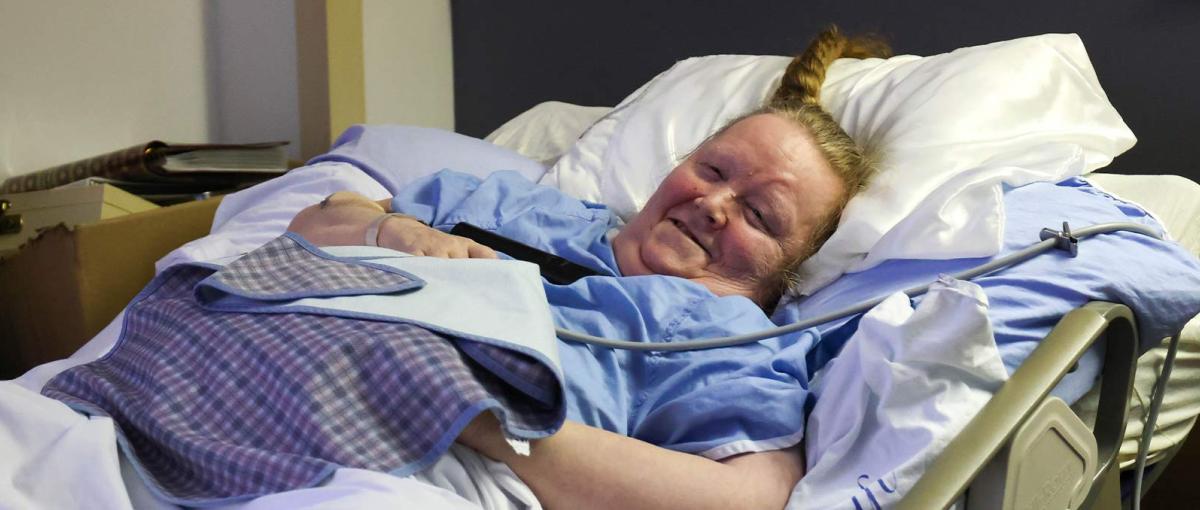Preventing and treating pressure injuries in long-term care requires special treatment

November 21, 2024
By Peter Rybar, social media advisor
For Dianna Sangster, the term “pain in the butt” is more than just a figure of speech — it’s an apt description of her ongoing battle with a pressure injury that has developed on her buttocks during her time in long-term care.
“It’s very achy and taking too long to heal,” says Dianna.
As a resident of Covenant Health’s Edmonton General Continuing Care Centre for nearly a decade, Dianna, 61, has multiple sclerosis (MS), and her pressure injury is just one of many challenges she’s faced. The injury began two years ago when her custom power wheelchair was sent for repair, leaving her to use a loaner chair that caused prolonged pressure on her skin. The injury has greatly affected her daily life.
“It limits the activities she can do and how long she can stay in her chair and be independent,” says Shazeen Ramji, resident care manager. “Because we have to get pressure off the area, she has to depend on the staff because she can't move around as much in bed as she would in her chair.”
Pressure injuries, also known as bedsores, are often preventable yet complex wounds that significantly impact quality of life, particularly for residents in long-term care. They occur when prolonged pressure on the skin reduces blood flow, leading to tissue damage. For residents like Dianna, who live with conditions such as MS and have limited mobility, the risk is heightened, and therefore special care is needed.
“The staff here are good about making sure I’m moved regularly and that I have the right equipment,” says Dianna.
Although these types of wounds can’t always be avoided, Covenant Health is committed to having systems and strategies in place to help stop pressure injuries before they occur, says Marlene Varga, clinical nurse specialist and pressure injury prevention lead.
Pressure injury prevention at the Edmonton General and other Covenant Health sites across Alberta is guided by the SSKIN+ protocol, a comprehensive strategy designed to address all critical aspects of care.
Regular skin inspections help staff identify early signs of damage before they worsen, while the use of specialized mattresses and cushions ensures pressure is evenly distributed to reduce strain on vulnerable areas.
Scheduled repositioning is also vital to alleviating prolonged pressure, and diligent moisture management keeps the skin clean and dry to prevent breakdown. In addition, nutrition and hydration are prioritized, since a well-balanced diet and sufficient fluid intake support skin health and promote healing.
Together, these measures form a holistic approach to preventing pressure injuries and maintaining residents’ well-being, says Marlene. “We’re proud of the systems we’ve put in place, like the SSKIN+ protocol.”
Pressure injury prevention at Covenant Health also extends beyond clinical protocols — it’s a culture of collaboration, Marlene says. She credits Covenant Health’s leadership for creating the dedicated role of pressure injury prevention lead, the first of its kind in Alberta.
"Our approach is evidence-informed and person-centered because we focus on prevention as a patient safety priority. It’s about recognizing risks early, intervening and involving everyone — patients, families and teams."
Clinical nurse specialist and pressure injury prevention lead, Covenant Health
The same necessity for teamwork applies to treating existing pressure injuries.
“We depend on many disciplines, families and the residents themselves. Without collaboration, the likelihood of healing can be very low,” says Shazeen.
For Dianna, the journey to healing has been slow and challenging. While she has her power wheelchair back, she requires significant care for her pressure injury.
“We’ve had to adjust her schedule so she’s not sitting on that area for too long,” says Shazeen. “It’s about balancing her independence and quality of life while ensuring her wound can heal.”
Despite her challenges with the pressure injury, Dianna remains optimistic about her care. “(The staff) are doing their best,” she says, with a smile. “It’s a pain in the butt, but I know they’re helping.”